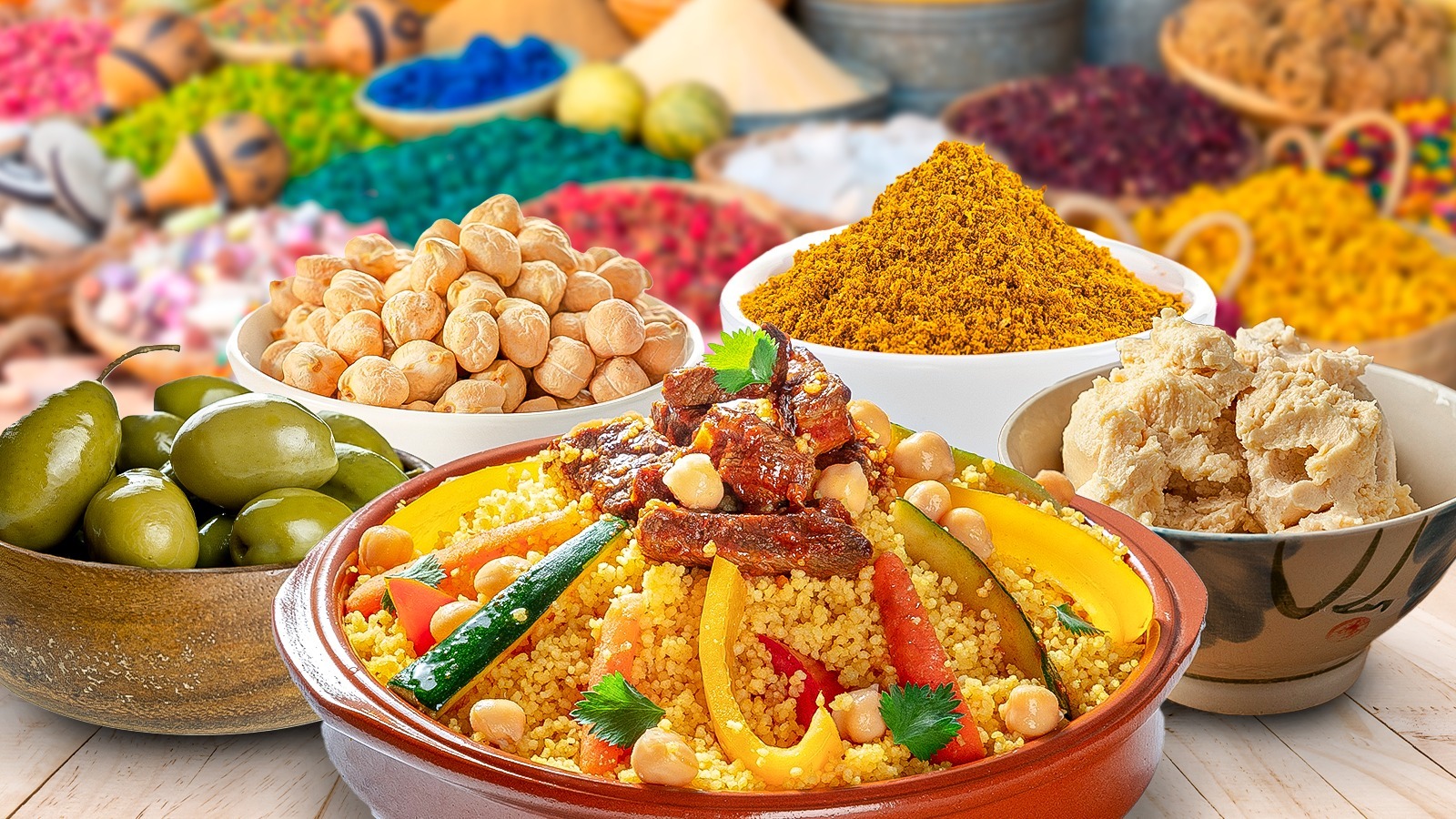Are you interested in exploring and learning about the best of Moroccan cuisine and culinary experiences? We'll begin with various types of fried eggs that I fondly remember from school trips. Next, we'll dive into iconic dishes like couscous and tagines, along with exploring unique spices and street foods. This guide is perfect for anyone eager to understand Moroccan cuisine. Regardless of any challenges, whether you're a visitor or simply vacationing across the country, we'll ensure you become well-acquainted with its culinary delights.
Unveiling the Flavors of Morocco
One of the defining characteristics of Moroccan cuisine is its bold, distinctive flavors. This rich culinary tradition reflects a blend of cultural and geographical influences, merging elements from Arab, Berber, Mediterranean, and Sub-Saharan African cuisines.
Moroccan dishes are renowned for their generous use of herbs and spices, including saffron, cinnamon, and other aromatic seasonings. The cuisine's diversity spans across different meals, offering a vibrant tapestry of flavors.
For those with varied linguistic backgrounds or reading challenges, assistive technology has proven essential in bridging these gaps. Moroccan dishes like tagines and couscous are slow-cooked over several hours, creating a culinary journey through gardens, deserts, mountains, and gatherings, with each bite offering a harmonious blend of tastes.
The essence of Moroccan food lies in its ability to seamlessly combine flavors from different ingredients. Each region boasts its own unique dishes, and everyday favorites like the rich ras el hanout spice mix and hearty tagine stews are central to this culinary experience.
These dishes exemplify Morocco's rich spice heritage, a legacy of blending ancestral culinary traditions into a unified, flavorful cuisine.
Couscous: The Beloved Staple
Morocco is renowned for its deep affection for couscous, a staple of North African cuisine that has become a beloved dish in Jamaica as well. Dating back to the 11th century, couscous remains a timeless favorite.
In Morocco, couscous is traditionally steamed over a fragrant broth, and it can be paired with stewed meats, vegetables, and a variety of sauces, or served alongside beans, rice, or tortillas. The dish can be enjoyed in classic versions with lamb or chicken, or prepared as a vegetarian option. Moroccan cuisine is also known for its flavorful condiments and fresh bread.
Preparing Moroccan couscous is a meticulous and intricate process, requiring precise steaming to achieve the soft yet flavorful morsels that complement most North African dishes. It can be enjoyed on its own or paired with tagines and sweet treats.
Moroccan chefs often get creative with couscous, incorporating seasonal produce to offer authentic flavors. Cafés serve dishes like saffron couscous or variations with dried fruits and nuts, showcasing the evolving art of cooking to meet the diverse tastes of food enthusiasts in Morocco.
Tagines: Slow-Cooked Deliciousness
Tagines are traditional Moroccan stews named after the earthenware pots in which they are cooked. This slow-cooking method allows the flavors to meld together harmoniously. The pot's design ensures that ingredients like meat, vegetables, fruit, and Moroccan spices cook slowly at low temperatures, resulting in a seamless blend of flavors.
A typical Moroccan restaurant menu features dishes such as lamb with prunes and almonds, and chicken with lemon and olives. These dishes highlight the depth and variety of Moroccan cuisine, alongside staples like couscous, fresh bread, and fish.
Tagines are a cornerstone of Moroccan cooking, known for their long, slow cooking process that enhances the flavors of spices, meats, and vegetables. This method is integral to Moroccan culinary traditions and reflects the culture's emphasis on careful, deliberate cooking.
More than just a dish, tagines embody Moroccan culture and history. They have deep roots in the traditions of the Berbers, the indigenous people of North Africa, who originally used these pots for cooking over open fires. Today, tagines continue to symbolize the rich culinary heritage and customs of Morocco.
Moroccan Breads: From Flatbreads to Sweets
In Morocco, bread is an essential part of daily meals, featuring a diverse range of options including flatbreads, pastries, and sweet breads. Among the most renowned is khobz, a staple found in bakeries and commonly enjoyed from street vendors. Moroccan bread stands out from that of neighboring countries, with a distinctive variety of syrupy and crispy pastries. For instance, msemmen is a cakey bread delicately soaked in honey, while chebakia consists of sweet, rosewater-scented crescent-shaped treats sprinkled with sesame seeds.
These breads and pastries are not just integral to Moroccan cuisine but also a significant part of everyday street food. They can be found in markets and on street corners, where their sweet and fruity aroma attracts both locals and visitors, encouraging them to share these special treats.
Bread in Morocco goes beyond being a simple side; it is versatile and can be used for sandwiches, added to meals, or enjoyed as a snack on the go. Khobz is soft and light, msemmen is flaky like a croissant, and chebakia is golden brown with a sweet, rosewater fragrance. These breads reflect Morocco's rich food culture and the skill of Moroccan bakers, offering a delightful taste of Moroccan cuisine that excites the palate and showcases the country’s culinary wonders.
Foods in Morocco: A Spice Adventure
Spices are central to Moroccan culinary art, imparting distinctive flavors and aromas.
Experience the vibrant spice markets in Marrakech and Fez, where you can immerse yourself in the rich scents used in Moroccan cooking. Ras el hanout, a complex blend of up to 30 spices, includes native ingredients like cumin, cinnamon, ginger, and chili. These spices are key to achieving the bold and deep flavors that characterize Moroccan cuisine.
The uniqueness of Moroccan food lies in its spices. Cumin adds a warm flavor, cinnamon contributes sweetness, and chili provides a spicy kick. Exploring exotic spices at the markets in Marrakech and Fez reveals the essence of Moroccan cuisine, offering a journey through its spicy dishes and sweet cakes a true adventure into a culinary world.
Moroccan spices reflect the country’s diverse culture and landscapes, each blend and dish showcasing its own identity. Local cuisine transcends mere sustenance; it embodies heritage and tradition. This diversity demonstrates how North Africa’s seasoning contributes to a wide range of flavors. Whether you’re a South African savoring the Moroccan tagine with its cumin-rich spices or an Italian captivated by North African cuisine, these flavors highlight the global appeal of Moroccan food.
Street Food Delights of Morocco
Embarking on a street food tour is a fantastic way to explore the rich food culture and customs of Morocco. For example, in bustling souks, fig and argan oil are celebrated, while in Essaouira, you can enjoy snacks from stalls set up along the picturesque seaside. Moroccan street food includes a variety of delights such as flatbread, harira soup, and the ever-popular kefta skewers.
To experience authentic Moroccan street food and gain insight into local traditions, watch this video: Hands-on participation is central to Moroccan street food culture, where sharing meals fosters a strong sense of community and joy. The vibrant, festive atmosphere is enhanced by the tantalizing aromas of spices and food. Immersing yourself in this lively food scene not only allows you to savor the flavors but also helps you appreciate the rich cultural heritage of Moroccan cuisine.
Regional Specialties: A Culinary Journey
Morocco, with its rich tapestry of diverse landscapes and cultures, offers a wide array of local delicacies. Along the coast, you'll find grilled sardines and fish marinated with chermoula. In the mountainous regions, hearty stews and tagines featuring lamb and vegetables reign supreme due to their comforting and nutritious qualities. The desert regions, on the other hand, are known for their unique herbs and Amazigh food traditions, adding yet another dimension to Moroccan cuisine.
Exploring these North African recipes reveals the incredible diversity of Moroccan food. The spices from the Atlas Mountains and the sun-soaked ingredients from the Sahara blend together to create a vibrant culinary experience. The menu, featuring dishes from various regions, showcases a beautiful fusion of flavors and traditions that reflect Morocco's rich cultural heritage.
Moroccan Sweets: Indulging in Sweetness
Moroccan cuisine is renowned for its rich and flavorful desserts and pastries, which highlight a delightful blend of flavors and textures. Classic examples include baklava, with its honey-soaked layers, and cornes de gazelle, made with almonds. These sweets feature a mix of spices, dried fruits, and creamy textures.
Honey is a key ingredient in traditional Moroccan treats like Chebakia and Halwa, which are often enjoyed alongside a cup of mint tea—a cornerstone of Moroccan tea culture.
The popularity of these desserts among food enthusiasts is a testament to Morocco’s culinary excellence. Moroccan pastry chefs are experts at crafting perfect blends of taste, creating an unforgettable experience with each bite.
Moroccan Tea Culture: Sipping Tradition
No exploration of Moroccan gastronomy is complete without delving into its tea culture. Moroccan mint green tea is central to this tradition, symbolizing the country's ethos of hospitality. This tea is widely recognized as a wonderful way to connect with others and forge new friendships. Made with green tea, fresh mint, and sugar, it is a staple found in markets and riad gardens throughout Morocco.
Tea time in Morocco often involves snacking and socializing, reflecting the nation’s multicultural character. Moroccan mint tea is more than just a refreshing drink; it represents a sense of unity and joy, embodying the warmth and tradition of Moroccan culture.
Dining Etiquette and Customs
When experiencing Moroccan cuisine, it's important to embrace local dining customs. Begin by expressing gratitude and complimenting your host after being served. It’s customary to eat with your right hand and to wash your hands before and after meals. These practices offer insight into the significance of Moroccan food in the culture.
Additionally, be mindful of where to sit, proper behavior, and the sequence of dining procedures. Following these etiquette guidelines will help you show appreciation and blend in like a local. When visiting Morocco, keeping these tips in mind will enhance your dining experience and ensure a memorable culinary adventure.
Conclusion
Moroccan cuisine is more than just food; it represents a rich fusion of diverse cultures across time. The culinary landscape includes a delightful mix of apricot pudding, spicy tagines, and aromatic couscous, complemented by sweet pastries and the renowned mint tea. Sampling Moroccan cuisine allows you to savor a world of flavors and aromas.
With its regional specialties, vibrant street food, and unique dining traditions, Morocco provides an unparalleled culinary experience. You'll return with a deep appreciation for Moroccan cooking and North African dishes.
Immerse yourself in the enticing aromas of spices, enjoy rich tagines, indulge in sweet treats, and finish with a refreshing mint tea in Morocco. It’s a remarkable journey where the sweet and spicy flavors capture the essence of its multicultural charm. Discover Morocco’s rich sensory experience—from the bustling markets of Marrakech to the serene towns of Essaouira, and understand why Morocco is a top destination for food enthusiasts.


